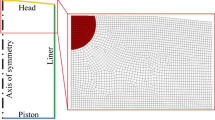Abstract
The main challenge facing the concept of gasoline direct injection is the unfavourable physical conditions at which the premixed charge is prepared and burned. These conditions include the short time available for gasoline to be sprayed, evaporated, and homogeneously mixed with air. These conditions most probably affect the combustion process and the cycle-by-cycle variation and may be reflected in overall engine operation. The aim of this research is to analyze the combustion characteristics and cycle-by-cycle variation including engine-out nanoparticulates of a turbocharged, gasoline direct injected spark ignition (DISI) engine at a wide range of operating conditions. Gasoline DISI, turbo-intercooled, 1.6L, 4 cylinder engine has been used in the study. In-cylinder pressure has been measured using spark plug mounted piezoelectric transducer along with a PC based data acquisition. A single zone heat release model has been used to analyze the in-cylinder pressure data. The analysis of the combustion characteristics includes the flame development (0–10% burned mass fraction) and rapid burn (10–90% burned mass fraction) durations at different engine conditions. The cycle-by-cycle variations have been characterized by the coefficient of variations (COV) in the peak cylinder pressure, the indicated mean effective pressure (IMEP), burn durations, and particle number density. The combustion characteristics and cyclic variability of the DISI engine are compared with data from throttle body injected (TBI) engine and conclusions are developed.
Similar content being viewed by others
References
Ando, H. (1996). Combustion control technologies for gasoline engines. Lean Burn Combustion Engine IMechE Seminar, Paper S433/001/96, 1996–1920.
Brown, A. G., Stone, C. R. and Beckwith, P. (1996). Cycleby-cycle variations in spark ignition engine combustion — Part l: Flame speed and combustion measurements and a simplified turbulent combustion model. SAE Paper No. 960612.
Clerk, D. (1886). The Gas Engine. Longmans Green. London.
Eriksson, L., Nilsen, L. and Glavenius, M. (1997). Development of control algorithm stabilizing torque for optimal position of pressure peak. SAE Trans. J. Engines, 106, 1216–1223.
Gao, J., Jiang, D., Huang, Z. and Wang, X. (2005). Experimental and numerical study of high-pressure-swirl injector sprays in a direct injection gasoline engine. Proc. IMechE, 219Part A: J. Power and Energy.
Geiger, J., Grigo, M., Lang, O., Wolters, P. and Hupperich, P. (1999). Direct injection gasoline engines — Combustion design. SAE Paper No. 1999-01-0170.
Hinze, P. C. and Cheng, W. K. (1998). Effects of charge composition on SI engine cyclic variations at idle. 4th Int. Symp. COMODIA 98.
Itoh, T., Liama, A., Muranaka, S. and Tagaki, Y. (1998). Combustion characteristics of a direct-injection stratified charge S.I. engine. JSAE Review, 19, 217–222.
J. B. Heywood (1988). Internal Combustion Engine Fundamentals. McGraw-Hill Int. Series, Automotive Technology Series. Boston.
Jackson, N. S., Stokes, J., Whitaker, P. A. and Lake, T. H. (1996). A direct injection stratified charge gasoline combustion system for future european passenger cars. Lean Burn Combustion Engine IMechE Seminar. 1996–1920.
Kume, T., Iwamoto, Y., Lida, K., Murakami, M., Akishino, K. and Ando, H. (1996). Combustion control technologies for direct injection SI engines. SAE Paper No. 960600.
Litak, G., Kaminski, T., Czarnigowski, J., Sen, A. K. and Wendeker, M. (2009). Combustion process in a spark ignition engine: Analysis of cyclic peak pressure and peak pressure angle oscillations. Meccanica, 44, 1–11.
Matsumoto, K., Tsuda, I. and Hosoi, Y. (2007). Controlling engine system: A low-dimensional dynamics in a spark ignition engine of a motorcycle. Z Naturforsch, 62a, 587–595.
Muller, R., Hemberger, H. and Baier, K. H. (2001). Engine control using neural networks; A new method in engine management systems. Meccanica, 32, 423–430.
Patterson, D. J. (1966). Cylinder pressure variations, a fundamental combustion problem. SAE Paper No. 660129.
Roy, M. R. (2011). Performance and emissions of a diesel engine fueled by diesel-biodiesel blends with special attention to exhaust odor. Canadian J. Mechanical Sciences and Engineering 2,1, 1–10.
Sawamoto, K., Kwamura, Y., Kita, T. and Matsushita, K. (1987). Individual cylinder knock control by detecting cylinder pressure. SAE Paper No. 871911.
Wagner, R. M., Daw, C. S. and Thomas, J. F. (1993). Controlling chaos in spark-ignition engines. Proc. Central and Eastern States Joint Technical Meeting of the Combustion Institute, 15–17, New Orleans.
Author information
Authors and Affiliations
Corresponding author
Rights and permissions
About this article
Cite this article
Hassaneen, A.E., Samuel, S. & Whelan, I. Combustion instabilities and nanoparticles emission fluctuations in GDI spark ignition engine. Int.J Automot. Technol. 12, 787–794 (2011). https://doi.org/10.1007/s12239-011-0091-z
Received:
Revised:
Published:
Issue Date:
DOI: https://doi.org/10.1007/s12239-011-0091-z




